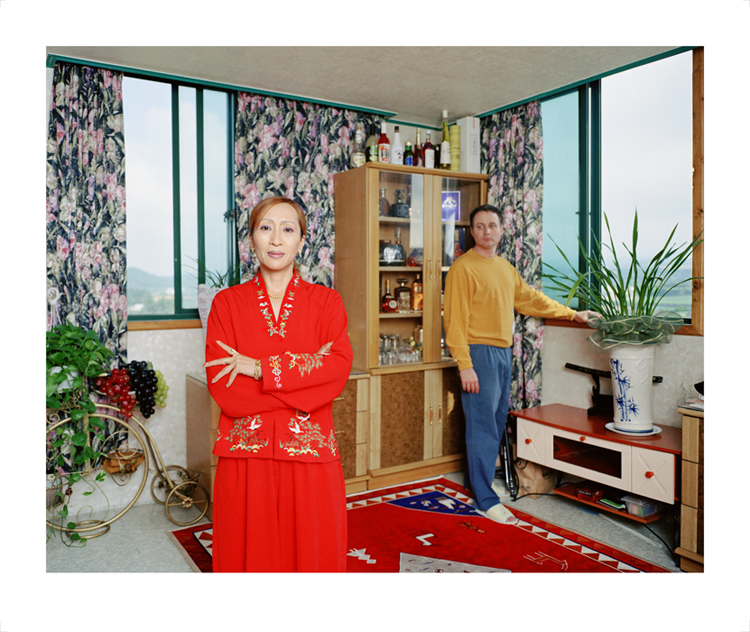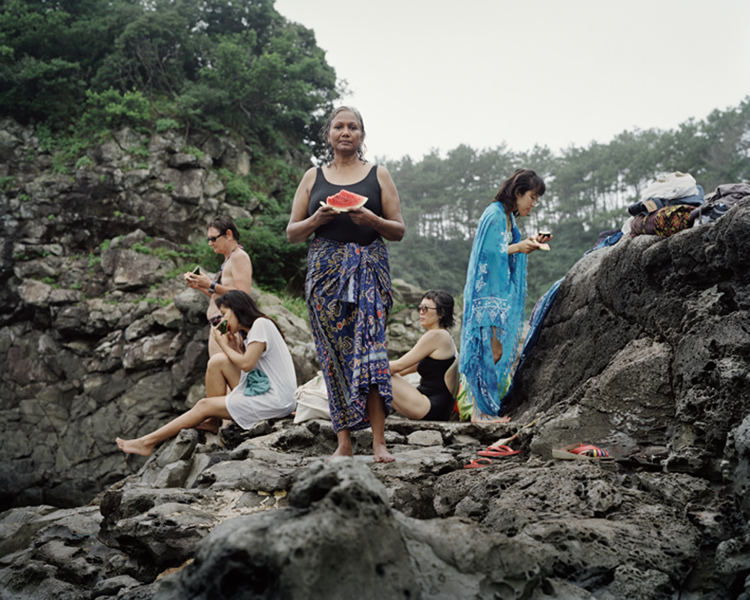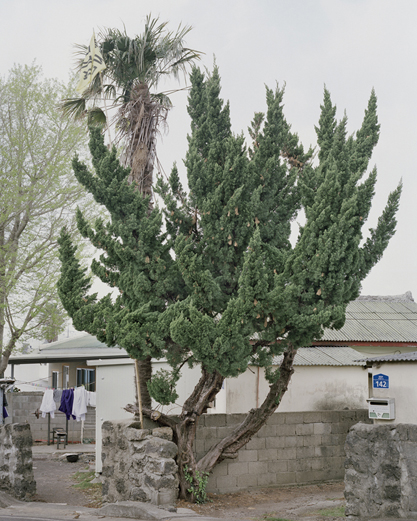金玉善 KIM Oksun

《ヒロヨとマイケル2》〈ハッピー・トゥゲザー〉より 2004年 発色現像方式印画 96×114 cm
Happy Together_Hiroyo and Michael 2, 2004, Chromogenic print, 96×114 cm
金玉善
KIM Oksun
1967年、韓国、ソウル市生まれ。韓国、済州島に在住、ソウルおよび海外で活動。
「済州島における異文化について─キム・オクソン(金玉善)」 笠原美智子
異文化との遭遇はキム・オクソンにとっては日常である。彼女の日常は出世作となった〈ハッピー・トゥゲザー〉(2000-2005年)に直接反映している。写るのはアジア系の女性と白人男性のカップルで、タイトルの名前から女性は韓国・日本・中国等のアジア系であることがわかる。何組かはゲイやレズビアンで、アジア系の女性/男性と白人の女性/男性が混じる。(中略)それを大型の4×5インチのビュー・カメラで細部まで計算し尽くして構成し、被写体となった人々がよそいきではない表情を浮かべる瞬間を捉えているのである。(中略)1点1点の写真は、それぞれが長編ドラマを語り出しそうな示唆に満ちている。そしてそこに響くキム・オクソンの「一緒にいて幸せ?」という問いには、簡単な「はい」も「いいえ」もないだろう。複雑で曖昧な感情と結婚という生活そのものがそこには写っているのである。(中略)
もちろんキム・オクソンの写真に写る白人男性の中には「従順なアジアの女性」という幻想を抱いて結婚した人もいるかもしれない。韓国人男性と結婚した東南アジアの女性にしても、男性に従順なだけの女性など絶滅危惧種のようなものであることを早晩理解することだろう。女性が外国人と結婚することや、またレズビアンであることは、即座に伝統的価値観を守ろうとする社会からの逸脱を意味する。キム・オクソンの写真に見る女性の眼差しの強さは、そうした多くの困難を引き受ける覚悟の上のものなのだろう。
異文化との葛藤や調和、アイデンティティの確認といったテーマは、済州島に暮らす外国人のポートレイト〈ノー・ディレクション・ホーム〉(2009-2011年)や済州島に持ち込まれて根付いた植樹のシリーズ〈輝くもの〉(2011年-)にも引き継がれている。(中略)キム・オクソンの〈ノー・ディレクション・ホーム〉に登場する外国人たちもこの恩恵を受けた人たちがいるかもしれない。ボブ・ディランの「ライク・ア・ローリング・ストーン」のリリックに因んだこのタイトルは「帰る場所を持たずに」済州島に暮らす人々を示唆している。しかしキム・オクソンが描く彼らの表情には、楽観的な微笑みも、悲観的な不安も浮かばない。彼らはじっと現実を見据えているように見える。(中略)
「外来植物が主な被写体であるシリーズ〈輝くもの〉は、外国の地に住んでいる人たちの隠喩にほかなりません。済州島の絡み合いねじ曲がった高木は、異質な環境で生き延びている異邦人たちを象徴しています」(金玉善)。彼らの中には、外から運ばれて済州島の正房瀑布やソギィポ市に深く根を張る大木のように、故郷を遠く離れて済州で根を張り島の人になる人がいるかもしれない。あるいは現代のノマドさながら、新たな地平を求めて済州島を離れる人もいるかもしれない。いずれにせよ重要なのは、どのような動機であっても、消極的にであれ積極的にであれ、彼らは自分の意思で住む場所を決めていることである。それは異文化の中で生きる不安定さやリスク、自分を相対化せざるをえない困難と同時に、自由を引き受けることでもあるのだろう。
笠原美智子「愛について アジアン・コンテンポラリー」より一部抜粋、「愛について アジアン・コンテンポラリー」展図録、東京都写真美術館、2018年
Born in Seoul, Korea, 1967.
Lives on Jeju-Island in Korea and works in Seoul and worldwide.
Regarding Foreign Cultures on Jeju Island—Kim Oksun KASAHARA Michiko
For Kim Oksun, encounters with foreign cultures are a common occurrence. Her daily experiences are reflected directly in what has become her breakthrough work, Happy Together (2002–2005). The subject of her photographs is mixed couples, consisting of a Western man and Asian woman, and as we can tell from the titles, the women originate from Korea, Japan, China, etc. Some of the couples consist of gays or lesbians and also some Asian or Caucasian couples appear among them. [……] Using a large-format 4×5 camera and a minutely calculated composition, she captures her subjects in the moment when their expressions cease to be formal. [……] Each photograph is filled with hints of the long drama they contain and in them there can be found no simple yes or no answer to question posed by Kim Oksun, ‘Are you happy together?’ [……] The marriages portrayed in Kim Oksun’s photographs depict the confrontation of two individuals, and therefore each possesses different implications. [……]
Of course, among the white men in Kim Oksun’s photographs there may be those who believed the fantasy of the ‘subservient Asian woman’ when they married. The Korean men who married Southeast Asian women probably soon discovered that women who are totally subservient to men are rapidly becoming an endangered species. For a woman to marry a foreigner or to be gay immediately indicates a deviation from the norms of a society that strives to preserve traditional values. The strength of the gazes of the women who appear in Kim Oksun’s photographs demonstrate a resolution to stand up to all the difficulties they can expect to face.
She continues to work on themes of conflict/harmony between different cultures and identity in her series of portraits of foreigners living on Jeju Island, No Direction Home (2009–2011) and her series on plants that were introduced to Jeju Island and flourished there, The Shining Things (2011). [……]
Kim Oksun’s No Direction Home series comes from the lyrics of Bob Dylan’s ‘Like a Rolling Stone’ and is used to describe the people who live in Jeju. However, in the expressions of the people depicted by Kim Oksun we see neither optimistic smiles nor a pessimistic unease, instead they appear to confront reality steadfastly. [……]
The Shining Things show the non-native vegetations on Jeju Island and the tangled and twisted arbors symbolize the strangers who are survived from different surroundings. Whichever the case, no matter what their motives, negative or positive, they have made a conscious decision to live in foreign environment. They accept the insecurity and risks they confront through living in a different culture and the difficulties of having to relativize themselves, while simultaneously accepting their freedom.
Text by KASAHARA Michiko, Extract from“I know something about love, asian contemporary photography”, I know something about love, asian contemporary photography (exh.cat.),Tokyo Photographic Art Museum, 2018 (Translated by Gavin FREW)
更新された最新の情報は、作家のウェブサイトをご覧ください。
Please refer to the artist’s website for new updates.


《リーラと友だち》〈ノー・ディレクション・ホーム〉より 2010年 発色現像方式印画 120×150 cm
No Direction Home_Leela and her friends, 2010, Chromogenic print, 120×150cm

《無題》〈輝くもの(済州島)〉より 2013年 発色現像方式印画 100×80 cm
The Shining Things(Jeju Island)_Untitled_wolpyung142, 2013, Chromogenic print, 100×80cm
All photos credit : KIM Oksun

